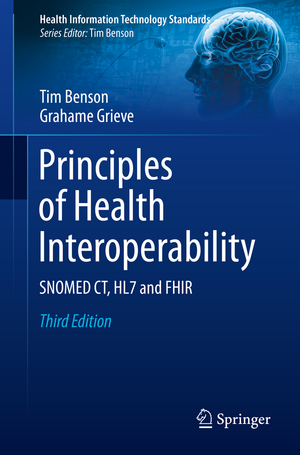Principles of Health Interoperability: FHIR, HL7 and SNOMED CT: Health Information Technology Standards
Autor Tim Benson, Grahame Grieveen Limba Engleză Paperback – 20 oct 2020
Principles of Health Interoperability has been completely re-organised into five sections. The first part covers the core principles of health interoperability, while the second extensively reviews FHIR. The third part includes older HL7 standards that are still widely used, which leads on to a section dedicated to clinical terminology including SNOMED CT and LOINC. The final part of the book covers privacy, models, XML and JSON, standards development organizations and HL7 v3. This vital new edition therefore is essential reading for all involved in the use of these technologies in medical informatics.
Preț: 389.61 lei
Preț vechi: 410.12 lei
-5% Nou
Puncte Express: 584
Preț estimativ în valută:
74.56€ • 80.96$ • 62.63£
74.56€ • 80.96$ • 62.63£
Carte disponibilă
Livrare economică 01-15 aprilie
Livrare express 15-21 martie pentru 43.36 lei
Preluare comenzi: 021 569.72.76
Specificații
ISBN-13: 9783030568825
ISBN-10: 3030568822
Pagini: 475
Ilustrații: XVIII, 475 p. 110 illus., 35 illus. in color.
Dimensiuni: 155 x 235 x 33 mm
Greutate: 0.68 kg
Ediția:4th ed. 2021
Editura: Springer International Publishing
Colecția Springer
Seria Health Information Technology Standards
Locul publicării:Cham, Switzerland
ISBN-10: 3030568822
Pagini: 475
Ilustrații: XVIII, 475 p. 110 illus., 35 illus. in color.
Dimensiuni: 155 x 235 x 33 mm
Greutate: 0.68 kg
Ediția:4th ed. 2021
Editura: Springer International Publishing
Colecția Springer
Seria Health Information Technology Standards
Locul publicării:Cham, Switzerland
Cuprins
Contents.- Foreword.- Preface.- Part 1 Principles of Health Interoperability.- The Health Information Revolution.- Why Interoperability is Hard.- Terminology, Content, Exchange.- Safety Thinking.- Part 2 FHIR.- FHIR Principles.- FHIR API.- FHIR Resources - Administrative.- FHIR Resources – Clinical Summary.- FHIR Terminology.- FHIR Implementing FHIR.- Part 3 Other Exchange Standards.- HL7 Version 2.- CDA.- IHE XDS.- Part 3 Terminology.- Clinical Terminology / Coding and Classification.- SNOMED CT+ Concept Model.- LOINC.- Terminology & Content models.- Mapping between Terminologies.- Terminology Services.- Part 4 Security & Privacy.- Security : TLS & OAuth.- Integrity: Provenance and Audit Trails.- Privacy and Consent.- Part 5 Supporting Standards.- UML, XML, JSON.- Standards Development Organizations.- The HL7 V3 Framework.- Glossary.- Bibliography.
Notă biografică
Tim Benson graduated from the University of Nottingham as a mechanical engineer. He founded one of the first GP computer suppliers (Abies Informatics Ltd). There, with James Read and David Markwell, he helped develop the Read Codes, which became one of the two sources of SNOMED CT. He led the first European project team on open standards for health interoperability and was a co-chair of the HL7 Education Committee for several years. He has developed a family of short generic outcome and experience measures (PROMs and PREMs) with R-Outcomes Ltd.
Grahame Grieve is FHIR Product Director at HL7 and is the founder of FHIR. Grahame travels the world giving lectures, guiding connectathons and advising governments, vendors and care providers about all aspects of interoperability. He graduated from the University of Auckland as a biochemist, worked as a clinical diagnostic scientist and medical researcher before joining Kestral Computing P/L,a Laboratory and Imaging Information Systems vendor and then setting up Health Intersections Ltd. A growing involvement in integration and interoperability lead him to the HL7 community where he has led committees and edited standards for HL7 v2, v3 and CDA. The outcome of this was to recognize that something new was needed, which led to the creation of the FHIR specification.
Grahame Grieve is FHIR Product Director at HL7 and is the founder of FHIR. Grahame travels the world giving lectures, guiding connectathons and advising governments, vendors and care providers about all aspects of interoperability. He graduated from the University of Auckland as a biochemist, worked as a clinical diagnostic scientist and medical researcher before joining Kestral Computing P/L,a Laboratory and Imaging Information Systems vendor and then setting up Health Intersections Ltd. A growing involvement in integration and interoperability lead him to the HL7 community where he has led committees and edited standards for HL7 v2, v3 and CDA. The outcome of this was to recognize that something new was needed, which led to the creation of the FHIR specification.
Textul de pe ultima copertă
This extensively updated fourth edition expands the discussion of FHIR (Fast Health Interoperability Resources), which has rapidly become the most important health interoperability standard globally. FHIR can be implemented at a fraction of the price of existing alternatives and is well suited for use in mobile phone apps, cloud communications and electronic health records. FHIR combines the best features of HL7’s v2, v3 and CDA while leveraging the latest web standards and clinical terminologies, with a tight focus on implementation.
Principles of Health Interoperability has been completely re-organised into five sections. The first part covers the core principles of health interoperability, while the second extensively reviews FHIR. The third part includes older HL7 standards that are still widely used, which leads on to a section dedicated to clinical terminology including SNOMED CT and LOINC. The final part of the book covers privacy, models, XML and JSON, standards development organizations and HL7 v3. This vital new edition therefore is essential reading for all involved in the use of these technologies in medical informatics.
Principles of Health Interoperability has been completely re-organised into five sections. The first part covers the core principles of health interoperability, while the second extensively reviews FHIR. The third part includes older HL7 standards that are still widely used, which leads on to a section dedicated to clinical terminology including SNOMED CT and LOINC. The final part of the book covers privacy, models, XML and JSON, standards development organizations and HL7 v3. This vital new edition therefore is essential reading for all involved in the use of these technologies in medical informatics.
Caracteristici
Updated edition containing sections on SNOMED CT, HL7 and FHIR Authored by two of the most experienced teachers of SNOMED CT, HL7 and FHIR Accessible to both relative novices and more experienced practitioners

